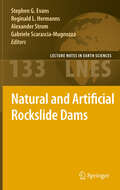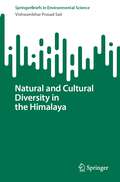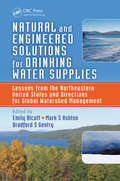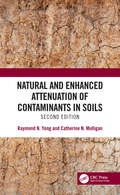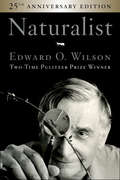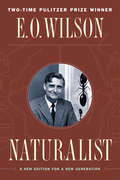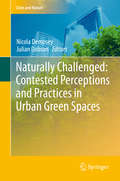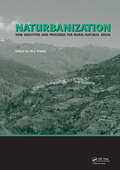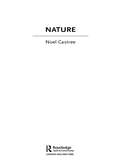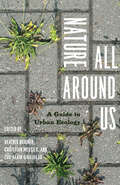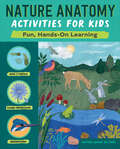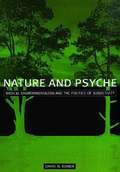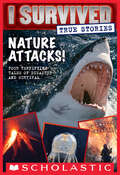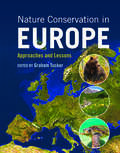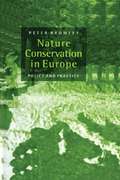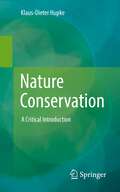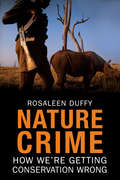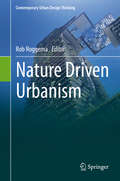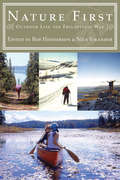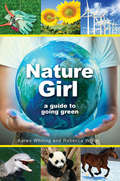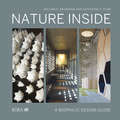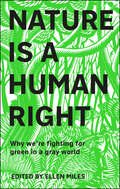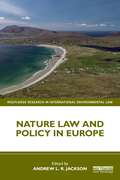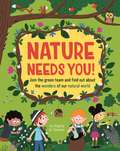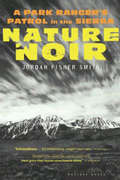- Table View
- List View
Natural and Artificial Rockslide Dams
by Reginald L. Hermanns Alexander Strom Stephen G. Evans Gabriele Scarascia-MugnozzaIn the last one hundred years, a number of catastrophic events associated with rockslide dam formation and failure have occurred in the mountain regions of the world. This book presents a global view of the formation, characteristics and behaviour of natural and artificial rockslide dams. Chapters include a comprehensive state-of-the-art review of our global understanding natural and artificial rockslide dams, overviews of approaches to rockslide dam risk mitigation, regional studies of rockslide dams in India, Nepal, China, Pakistan, New Zealand, and Argentina. Rockslide dams associated with large-scale instability of volcanoes are also examined. Detailed case histories of well-known historic and prehistoric rockslide dams provide examples of investigations of rockslide dam behaviour, stability, and characteristics. The formation and behaviour of rockslide-dammed lakes ("Quake Lakes") formed during the 2008 Wenchuan Earthquake, China are also comprehensively summarised. The formation, sedimentology and stability of rockslide dams is examined in several analytical papers. An analysis of break-out floods from volcanogenic lakes and hydrological methods of estimating break-out flood magnitude and behavior are reviewed. The use of remote sensing data in rockslide-dammed lake characterisation is explored and a new approach to the classification of rockslide dams is introduced. Finally, a unique section of the book summarises Russian and Kyrgyz experience with blast-fill dam construction in two papers by leading authorities on the technology. The volume contains 24 papers by 50 authors from 16 countries including most of the recognised world authorities on the subject.
Natural and Cultural Diversity in the Himalaya (SpringerBriefs in Environmental Science)
by Vishwambhar Prasad SatiThe Himalaya is the new folded mountain system – the tallest and the youngest in the world. It has a rich diversity – natural and cultural, and diversity in all walks of life. Most of its uniqueness is unknown because of its remoteness. Even, the native people are not aware of them. This book aims to describe the uniqueness of the Central Himalaya in terms of its natural and cultural diversity in detail. Supported by original figures and primary data, this book is empirically tested. It is mainly based on observation and participation and the use of a qualitative approach. Although lots of work has been carried out on the various aspects of the Himalayan region yet, a detailed description of the natural and cultural diversity is yet to be done. This book steps forward to elaborate on some of the unique natural and cultural features of the Central Himalaya, which are worthy to be known about. It contains a total of 10 chapters. Four chapters are devoted to natural diversity and four chapters comprise cultural diversity. Besides, the introduction and conclusions are the first and the last chapters of the book, respectively. The book is the first of its kind and will be useful to all stakeholders – students of all standards, research scholars, academicians, policymakers, native people, tourists, and the general public.
Natural and Engineered Solutions for Drinking Water Supplies: Lessons from the Northeastern United States and Directions for Global Watershed Management
by Mark S. Ashton Emily Alcott Bradford S. GentryIlluminating opportunities to develop a more integrated approach to municipal water system design, Natural and Engineered Solutions for Drinking Water Supplies: Lessons from the Northeastern United States and Directions for Global Watershed Management explores critical factors in the decision-making processes for municipal water system delivery. Th
Natural and Enhanced Attenuation of Contaminants in Soils, Second Edition
by Raymond N. Yong Catherine N. MulliganNatural attenuation has become an effective and low-cost alternative to more expensive engineered remediation. This new edition updates the principles and fundamentals of natural attenuation of contaminants with a broader view of the field. It includes new methods for evaluating natural attenuation mechanisms and microbial activity at the lab and field scales. Case studies, actual treatments and protocols, theoretical processes, case studies, numerical models, and legal aspects in the natural attenuation of organic and inorganic contaminants are examined. Challenges and future directions for the implementation of natural attenuation and enhanced remediation techniques are also considered.
Naturalist 25th Anniversary Edition
by Edward O. WilsonEdward O. Wilson – University Professor at Harvard, winner of two Pulitzer prizes, eloquent champion of biodiversity – is arguably one of the most important thinkers of the twentieth century. His career represents both a blueprint and a challenge to those who seek to explore the frontiers of scientific understanding. Yet, until now, little has been told of his life and of the important events that have shaped his thought.In Naturalist, Wilson describes for the first time both his growth as a scientist and the evolution of the science he has helped define. He traces the trajectory of his life – from a childhood spent exploring the Gulf Coast of Alabama and Florida to life as a tenured professor at Harvard – detailing how his youthful fascination with nature blossomed into a lifelong calling. He recounts with drama and wit the adventures of his days as a student at the University of Alabama and his four decades at Harvard University, where he has achieved renown as both teacher and researcher.As the narrative of Wilson's life unfolds, the reader is treated to an inside look at the origin and development of ideas that guide today's biological research. Theories that are now widely accepted in the scientific world were once untested hypotheses emerging from one man's broad-gauged studies. Throughout Naturalist, we see Wilson's mind and energies constantly striving to help establish many of the central principles of the field of evolutionary biology.The story of Wilson's life provides fascinating insights into the making of a scientist, and a valuable look at some of the most thought-provoking ideas of our time.
Naturalist: Conservation And Development In The Maya Forest Of Belize (Naturalist Directory And Almanac Ser.)
by Edward O. WilsonEdward O. Wilson -- University Professor at Harvard, winner of two Pulitzer prizes, eloquent champion of biodiversity -- is arguably one of the most important thinkers of the twentieth century. His career represents both a blueprint and a challenge to those who seek to explore the frontiers of scientific understanding. Yet, until now, little has been told of his life and of the important events that have shaped his thought.In Naturalist, Wilson describes for the first time both his growth as a scientist and the evolution of the science he has helped define. He traces the trajectory of his life -- from a childhood spent exploring the Gulf Coast of Alabama and Florida to life as a tenured professor at Harvard -- detailing how his youthful fascination with nature blossomed into a lifelong calling. He recounts with drama and wit the adventures of his days as a student at the University of Alabama and his four decades at Harvard University, where he has achieved renown as both teacher and researcher.As the narrative of Wilson's life unfolds, the reader is treated to an inside look at the origin and development of ideas that guide today's biological research. Theories that are now widely accepted in the scientific world were once untested hypotheses emerging from one mans's broad-gauged studies. Throughout Naturalist, we see Wilson's mind and energies constantly striving to help establish many of the central principles of the field of evolutionary biology.The story of Wilson's life provides fascinating insights into the making of a scientist, and a valuable look at some of the most thought-provoking ideas of our time.
Naturally Challenged: Contested Perceptions and Practices in Urban Green Spaces (Cities and Nature)
by Nicola Dempsey Julian DobsonThis book aims to understand how the wellbeing benefits of urban green space (UGS) are analysed and valued and why they are interpreted and translated into action or inaction, into ‘success’ and/or ‘failure’. The provision, care and use of natural landscapes in urban settings (e.g. parks, woodland, nature reserves, riverbanks) are under-researched in academia and under-resourced in practice. Our growing knowledge of the benefits of natural urban spaces for wellbeing contrasts with asset management approaches in practice that view public green spaces as liabilities. Why is there a mismatch between what we know about urban green space and what we do in practice? What makes some UGS more ‘successful’ than others? And who decides on this measure of ‘success’ and how is this constituted? This book sets out to answer these and related questions by exploring a range of approaches to designing, planning and managing different natural landscapes in urban settings.
Naturbanization: New identities and processes for rural-natural areas
by M. J. PradosAs the growth of the worlds population requires the continued search for residential space, the urbanization of natural lands is an inevitable process, but that process does not have to be one that is accomplished without regard for environmental quality. This book presents the unique perspective of naturbanization, the urbanization of protected a
Nature
by Noel CastreeExploring the shifting ways in which geographers have studied nature, this book emphasizes the relationships and differences between human geography, physical geography and resource and hazards geography. The first to consider the topic of nature in modern geography as a whole, this distinctive text looks at all its major meanings, from the human body and psyche through to the non-human world, and develops the argument that student readers should abandon the idea of knowing what nature is in favour of a close scrutiny of what agendas lie behind competing conceptions of it. It deals with, amongst others, the following areas: the idea of nature the 'nature' of geography de-naturalization and re-naturalization after-nature. As everything from global warming to GM foods becomes headline news, the use and abuse of nature is on the agenda as never before. Synthesizing a wealth of diverse and complex information, this text makes the significant theories, debates and information on nature accessible to students of geography, environmental studies, sociology, and cultural studies.
Nature All Around Us: A Guide to Urban Ecology
by Beatrix Beisner, Christian Messier, and Luc-Alain GiraldeauIt’s easy to stand in awe of a city’s impressive skyline, marveling at its buildings reaching for the clouds and its vast network of roadways and train lines crisscrossing in every direction. It can often seem like everything in a city is man-made, all concrete, steel, and glass. But even the asphalt jungle is not all asphalt—a sidewalk’s cracks are filled with nature, if we know where and how to look. To aid us in this quest is Nature All Around Us, which will help us to recognize (and look after) the natural world we traipse through in our daily lives. Nature All Around Us uses the familiar—such as summer Sundays humming with lawn mowers, gray squirrels foraging in planters, and flocks of pigeons—in order to introduce basic ecological concepts. In twenty-five short chapters organized by scale, from the home to the neighborhood to the city at large, it offers a subtle and entertaining education in ecology sure to inspire appreciation and ultimately stewardship of the environment. Various ecological concepts that any urban dweller might encounter are approachably examined, from understanding why a squirrel might act aggressively towards its neighbor to how nutrients and energy contained within a discarded apple core are recycled back into the food chain. Streaming through the work is an introduction to basic ecology, including the dangers of invasive species and the crucial role played by plants and trees in maintaining air quality. Taken as a whole, Nature All Around Us is an unprecedented field guide to the ecology of the urban environment that invites us to look at our towns, cities, and even our backyards through the eyes of an ecologist. It is an entertaining, educational, and inspiring glimpse into nature in seemingly unnatural settings, a reminder that we don’t have to trek into the wild to see nature—we just have to open our eyes.
Nature Anatomy Activities for Kids: Fun, Hands-On Learning (Anatomy Activities for Kids)
by Kristine BrownThink like a scientist and search like an explorer with this illustrated nature guide for kids ages 8 to 12Get ready to explore the sky above, the ground below, and all the plants and creatures in between! Made just for kids, this nature anatomy book teaches you about the incredible forces and living things that exist in nature.You'll dig in to tons of different topics—from naming the layers of the atmosphere to learning the parts of a flower—and try out fun activities like creating a mini cloud and raising a tadpole. As you explore the natural world around you, you'll become a real scientist by asking questions, imagining outcomes, testing your ideas, and then writing down what you discover.Nature Anatomy Activities for Kids includes:5 Subjects, 20 lessons—Dive in to different chapters for the earth, the sky, water, plants, and animals. Every chapter includes multiple lessons about the topic, with a new activity and a journal prompt for each.Journal like a scientist—Use your own blank journal to answer prompts and take notes so you can write and draw everything you observe or note any questions you want to find an answer for.Detailed illustrations—Colorful pictures and diagrams make this nature anatomy book fun to use and get kids excited about the anatomy of plants, animals, ecosystems, and landscapes.Get outside and explore with this book of nature anatomy activities that opens up a whole new world of learning.
Nature And Psyche: Radical Environmentalism And The Politics Of Subjectivity
by David KidnerNature and Psyche argues that psychological and environmental writing and action are all too often colonized by the same assumptions that inhibit ecological and cultural diversity. Industrialized monocultures conceal the character of our alienation from nature and, thus, prevent the emergence of effective solutions. Drawing on a diversity of disciplines, David Kidner illustrates that traditional psychological understanding is often inherently hostile to the natural order, and that the dominant form of selfhood that has emerged in the industrialized world promotes the domestication of nature. In fact, even some of the most radical environmentalists, who simplistically oppose technology, are also trapped within this paradigm. The author demonstrates that a more critical historical and cultural awareness, rooted in nature, can enable a re-integration of nature and psyche.
Nature Attacks! (I Survived True Stories #2)
by Lauren TarshisFrom the author of the New York Times-bestselling I Survived series come four harrowing true stories of survival, featuring real kids in the midst of epic disasters.REAL KIDS. REAL DISASTERS.The author of the New York Times-bestselling I Survived series brings us more harrowing true stories of real kids up against terrible forces of nature. From fourteen-year-old lone survivor of the shark attacks of 1916, to nine-year-old who survived the Peshtigo fire of 1871 (which took place on the very same day in history as the Great Chicago Fire!), here are four unforgettable survivors who managed to beat the odds.Read their incredible stories:The Deadly Shark Attacks of 1916The Great Peshtigo Fire of 1871A Venomous Box Jellyfish AttackThe Eruption of Mount Tambora
Nature Conservation in Europe: Approaches and Lessons
by Graham TuckerEuropean ecosystems and species remain under pressure from intensive agriculture and forestry, fishing, pollution, urban sprawl, invasive species and climate change. This book provides a detailed description and critical analysis of nature conservation responses, achievements and failures, motivated by the concerning state of nature and missed biodiversity targets. It summarises Europe's nature and the impact of human activities, and then gives an overview of relevant international biodiversity treaties and the EU nature conservation policy and legislative framework. The core of the book comprises chapters written by national experts, which cover the UK and twenty-five EU Member States, providing comparative case studies from which valuable lessons are drawn. Covering wide-ranging topics such as biodiversity pressures, legislation and governance, biodiversity strategies, species protection, protected areas, habitat management, and funding, this book is of interest to a wide audience, including academics and professionals involved in nature conservation and related environmental fields.
Nature Conservation in Europe: Policy and Practice
by Peter BromleyThe Rio Summit has pointed to the urgency for the development of an international conservation policy; and the post-Maastricht debates in Europe have highlighted the need for the EU to reassess structural funding in nature conservation, as well as the influences on policy and practice.This book is a 'route map' through the legislative and policy frameworks and explains how conservation works in Europe. It goes through the policies for nature conservation in the European Community and its constituent member states and sets out the mechanisms for delivering this policy.An understanding of the European legislative framework is now vital as its influence on local practice increases. Practitioners in the fields of countryside conservation and general land management will find the book an essential guide to the working of the EU, as well as helping an appreciation of their local role within the wider community objectives. This will, for example allow a better understanding of the grant system which many managers are now using.
Nature Conservation: A Critical Introduction
by Klaus-Dieter HupkeMany things happen in nature reserves that are contradictory at first glance. For example, flower meadows are mown down during maintenance work, even though all the plants growing there are protected. Elsewhere, protected reed beds are burnt down in a fen or the top layer of soil is removed with bulldozers in a dune conservation area. Still other areas are to remain completely untouched by human intervention. The author Klaus-Dieter Hupke shows the different strategies of nature conservation. He also shows that nature conservation is mostly not exactly what the term says in essence: "protection of nature". On the contrary, in Central Europe nature conservation areas are predominantly the relics of old agricultural and thus cultural landscapes. Often, aesthetic aspects of a landscape section are also in the foreground when designating it as a natural monument or nature reserve. Moreover, nature conservation runs the risk of becoming a substitute action and an alibi for a still growing destruction of traditional and near-natural landscape systems in Central Europe as well as globally.The updated second edition now explicitly includes the consequences of climate change for nature conservation and has also incorporated a stronger reference to Austria as well as to the central Alpine region in some places for the relevant readers.
Nature Crime
by Rosaleen DuffyIn this impressively researched, alarming book, Rosaleen Duffy investigates the world of nature conservation, arguing that the West's attitude to endangered wildlife is shallow, self-contradictory, and ultimately very damaging. Analyzing the workings of the black-market wildlife industry, Duffy points out that illegal trading is often the direct result of Western consumer desires, from coltan for cellular phones to exotic meats sold in London street markets. She looks at the role of ecotourism, showing how Western travelers contribute--often unwittingly--to the destruction of natural environments. Most strikingly, she argues that the imperatives of Western-style conservation often result in serious injustice to local people, who are branded as "problems" and subject to severe restrictions on their way of life and even extrajudicial killings.
Nature Driven Urbanism (Contemporary Urban Design Thinking)
by Rob RoggemaThis book discusses the way that a nature-driven approach to urbanism can be applied at each of the urban scales; architectural design, urban design of neighborhoods, city planning and landscape architecture, and at the city and regional scales. At all levels nature-driven approaches to design and planning add to the quality of the built structure and furthermore to the quality of life experienced by people living in these environments. To include nature and greening to built structures is a good starting point and can add much value. The chapter authors have fiducia in giving nature a fundamental role as an integrated network in city design, or to make nature the entrance point of the design process, and base the design on the needs and qualities of nature itself. The highest existence of nature is a permanent ecosystem which endures stressors and circumstances for a prolonged period. In an urban context this is not always possible and temporality is an interesting concept explored when nature is not a permanent feature. The ecological contribution to the environment, and indirect dispersion of species, from a temporary location will, overall add biodiversity to the entire system.
Nature First: Outdoor Life the Friluftsliv Way
by Bob Henderson Nils VikanderNature First combines the Scandinavian approach to creating a relationship with nature (known as friluftsliv) with efforts by Canadian and international educators to adapt this wisdom and apply it to everyday life experiences in the open air. The word friluftsliv literally refers to "free-air life" or outdoor life. A word saturated with values, the concept can permeate deeply and playfully into ones cultural being and personal psyche, thus influencing the way one perceives and interacts with nature on a daily basis. For centuries, the North American approach has been one of domination and bringing nature under control, in many cases abusing our natural environment in the process. The friluftsliv way of being on "talking terms with nature," developing an "insider’s" relationship with nature, offers the rich potential of allowing us as cohabiters on the Earth to recreate, rejuvenate and restore the balance among all living things. Nature First is the first English-language anthology to bring together the perspectives and experiences of North American, Norwegian, Swedish and other international outdoor writers, all friluftsliv thinkers and doers. Here, the thirty contributors’ use of history, sociology, psychology, philosophy and outdoor education writings blend to provide an understanding of how friluftsliv applies to everyday life. The book presents an alternative to much of the personal growth/adventure-based literature that tends to dominate our current approach to the outdoor activity. Folklore, heritage, adventure travel, crafts, place-based education and the daily outings of families all have a role to play in promoting an understanding of both the ordinary and the mystical importance of this Nordic tradition. Dedicated to parents, travel guides, educators and generally to participants in the outdoors, Nature First provides a compellingly fresh approach to life in the out-of-doors.
Nature Girl: A Guide to Caring for God's Creation
by Karen Whiting Rebecca WhiteLove God, Love the Planet As you become an expert in all things green, Nature Girl offers fun ways to care for God’s creations while enjoying the wonders of nature! With activities, recipes, science experiments, and much more, you can discover how to create recycled jewelry, plan a spa day with friends, make your own earth-friendly skin care products, or team up to clean a park or a neighbor’s yard. Each chapter covers different topics, like water, air, energy, and recycling, and includes crafts, Scripture, games, quizzes, interviews with experts, and quotes from real girls like you. From the itty-bitty flowers at your feet to the air high above your head, discover how you can make a difference for our planet.
Nature Inside: A biophilic design guide
by William D. Browning Catherine O. RyanWritten by a leading proponent of biophilic design, this is the only practical guide to biophilic design principles for interior designers. Describing the key benefits, principles and processes of biophilic design, Nature Inside illustrates the implementation of biophilic design in interior design practice, across a range of international case studies – at different scales, and different typologies. Starting with the principles of biophilic design, and the principles and processes in practice, the book then showcases a variety of interior spaces – residential, retail, workplace, hospitality, education, healthcare and manufacturing. The final chapter looks ‘outside the walls’, giving a case study at the campus and city scale. With practical guidance and real-world solutions that can be directly-applied in day-to-day practice, this is a must-have for designers interested in applying biophilic principles.
Nature Is A Human Right: Why We're Fighting for Green in a Gray World
by Ellen MilesFighting for a green world — a collection of essays and writing for building an equal, healthier society. Access to the natural world is a human right. This inspiring book captures why contact with nature is essential for our mental, social and physical well-being — and how we can rethink urban development to create green city spaces and a return to nature.Find an inspiring collection of original writings from world-leading &“green&” voices and discover: • Benefits and issues surrounding our access to nature • Discussions on social and environmental justice • Why we need nature around us, how we&’re being deprived of nature and what we can all do to change environmental and social issues • Edited by the founder of the environmental justice campaign Nature is a Human Right, Ellen Miles Concrete outweighs every tree, bush, and shrub on Earth. Nature deprivation is a fast-growing epidemic, harming the health and happiness of hundreds of millions of people worldwide — especially vulnerable and marginalized groups. Nature is a Human Right, founded by Ellen Miles in 2020, is working to make access to green space a recognized right for all, not a privilege.This book brings together a collection of engaging, accessible essays, interviews and exercises, from expert ambassadors and supporters (including authors, artists, scientists, human rights experts, television presenters, TED speakers, and climate activists). Each contributor offers a new perspective on why contact with nature should be a protected human right. Enlightening and sometimes uncomfortable, this collection of writing and ideas illuminate the work that needs to be done to make our global future happier.
Nature Law and Policy in Europe (Routledge Research in International Environmental Law)
by Andrew L. R. JacksonThis volume considers current and future challenges for nature law and policy in Europe. Following the Fitness Check evaluation of the Birds and Habitats Directives, in 2017 the EU adopted an Action Plan for nature, people and the economy to rapidly improve the Directives’ implementation and accelerate progress towards the EU's biodiversity targets for 2020. More recently, the EU has adopted a Biodiversity Strategy for 2030 and proposed an EU Nature Restoration Law. This book makes a timely contribution by examining the current state of play in light of recent and historical developments, as well as the post-2020 nature law and policy landscape. While evidence suggests that Natura 2000 and the Habitats and Birds Directives have delivered conservation benefits for wildlife in Europe, biodiversity loss continues apace. The book reviews the requirements for an effective international nature conservation system, with reference to the Birds and Habitats Directives. It examines regulatory regimes, current legal issues in the fields of site protection and species protection, the protection of areas outside Natura 2000, recent developments in the EU and the UK, including the implications of Brexit, agriculture and nature conservation, litigation, science and access to justice. Written by leading experts in the field, from a range of stakeholder groups, the volume draws on diverse experiences as well as providing interdisciplinary perspectives. This volume will be essential reading for students, scholars, practitioners, NGOs and policy-makers interested in European environmental policy and law, including for example lawyers, ecologists, environmental scientists, political scientists, natural resource managers, planners and civil servants.
Nature Needs You!: Join the Green Team and find out about the wonders of our natural world
by Liz GogerlyFour friends, Anjali, Lulu, Mason and Noah, discover an injured fox in the garden and need to take it to an animal rescue centre. There, they begin a year of discovery learning about the amazing animals, plants and places that make up our natural world.As the year goes on the children talk to lots of different people, from park rangers and environmentalists, to teachers and grandparents. They learn lots of things about the natural world, from biodiversity, food chains and climate change to pollination, plastic pollution and ecosystems.Throughout there are 'Take Action' advice panels, which give examples of small ways that people can get involved to help protect nature.Get Busy activity suggestions encourage children to be actively engaged with nature, by birdwatching or planting wild flowers.There are also full-page, step-by-step activities for how to make a bug hotel and a bird feeder.By the end of the book, readers will have a better understanding of the importance of nature, humans impact on nature and what can be done to help protect itLook out for the other titles in this series: Go Green, Wild Weather and Save our Seas.
Nature Noir: A Park Ranger's Patrol in the Sierra
by Jordan Fisher Smith&“A nature book unlike any other…peppered with gritty, anti-romantic, all-too-real tales of cops &’n&’ bad guys in the great outdoors.&”—The San Diego Union-Tribune Jordan Fisher Smith&’s startling account of fourteen years as a park ranger thoroughly dispels our idealized visions of life in the great outdoors. Instead of scout troops and placid birdwatchers, Smith's beat—a stretch of land that has been officially condemned to be flooded—brings him into contact with drug users tweaked out to the point of violence, obsessed miners, and other dangerous creatures. In unflinchingly honest prose, he both portrays the breathtaking natural world around him and reveals the unexpectedly dark underbelly of patrolling and protecting public lands. &“Gloriously unlike anything I&’ve ever read before…gives entree into a strange, dark, and mesmerizing outdoor world that's absolutely unforgettable.&”—The Boston Globe &“By turns funny, poignant and surprising…an intimate memoir of the career of a state-park ranger. Not just any ranger, but one with a wicked pen, patrolling a doomed landscape.&”—Seattle Times/Post-Intelligencer &“Compelling…refreshingly unsentimental.&”—Barry Lopez, author of Arctic Dreams &“Smith offers a fresh perspective on our threatened environment…Nature Noir reflects the spirit of an era as did Desert Solitaire.&”—Charlotte Observer
